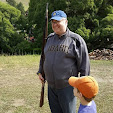We played the Belmont scenario from the "Heartland" scenario book. Grant, with two green brigades, must burn the Confederate camp at Belmont. The terrain is heavily wooded, and most of the rebels are in line of battle in a large field.
 Rebel Defense (click on all pictures for larger images)
Rebel Defense (click on all pictures for larger images)This is the main rebel defense, three regiments and a battery. At this stage of the war (November of 1861), the regiments were huge! Most CSA regiments were 32-36 figures, representing 640-720 men.
My Civil War armies are mostly made up of Musket Miniatures figures, although I have many Old Glory, Battle Honors, and Stone Mountain fixed in. I also have two Confederate regiments made up of Peter Pig figures.
My Civil War armies are mostly made up of Musket Miniatures figures, although I have many Old Glory, Battle Honors, and Stone Mountain fixed in. I also have two Confederate regiments made up of Peter Pig figures.
Jon had command of McClernand's brigade. His lead regiment came under artillery fire as it moved along the road, causing the division to revert to "hold" orders. Jon quickly shook his brigade out into line. The CSA artillery then took the Union guns under fire. Although Jon kept pushing the Union guns to the front, they were never able to unlimber and return fire.
The Illinois Cavalry detachment dismounted and formed a skirmish line at the edge of the field.
 McClernand's Attack
McClernand's AttackGrant gave McClernand orders to "engage" the enemy brigade, and Jon's regiments took the Confederates under fire. Austin commanded the Confederates, and he made up for weeks of unlucky dice in this one game. Jon and I managed to roll low all game. Austin also managed his regiments skillfully, refusing his right and extending his left to turn the Union right.
Austin refused his right and poured a devastating fire into the Union regiments. The Confederate troops were mostly militia, but there were a lot of them, and they fired like veterans! I made a mistake in computing the fire modifiers, counting the Confederate militia as green troops, but the way Austin was rolling, it didn't make much difference.
The linchpin of Austin's defense was his single battery of four six pounder smoothbore cannon. These green gunners scored hit after hit with canister. First they inflicted heavy casualties on Jon's infantry, then they inflicted fifty percent casualties on the limbered Union artillery.
BdGen Grant, on the white horse, watched his regiments take a pounding. Both of his brigades have "engage" orders, but the Union infantry is having a difficult time hitting all those Confederates in the open.
Dougherty's brigade, which I commanded, moved to fire on the Confederate line. Although not as roughly handled as McClernand, Dougherty was taking fire from two directions. At the top left of this picture, you can see McClernand's right starting to fall back. The green Union troops retreated under Austin's heavy fire.
With McClernand's line crumbling, Confederates working their way around the Union right, and Dougherty failing to make any headway, Grant decided to fall back. The Confederates held the field.
This was our first time using the GaG rules, and we certainly made some mistakes. Still, I think the rules made for a realistic game. I'm excited to try them again and see if attacking troops can make better headway with more even dice rolls.

















Wonderful report. I'm slowing working on some ACW units at the moment (in 25mm) for "Guns of Gettysburg".
ReplyDeleteBest wishes
Giles
Me too! I took advantage of the big Sash and Saber scale to buy WAY too many 25s.
ReplyDeleteHeh heh, I also bought a TON; about 300 figures per side. Can't wait to get them all painted up!:)
ReplyDeleteReally love the blog!
Lol, funny how things to develop in same direction, even though everything else is different - I've run same scenario with 6mm and 'They Couldn't Hit An Elephant' rules and scenario played in almost exactly same way.
ReplyDeleteBTW, great blog and I have to admit that I'm green of envy over your painting output. :-)